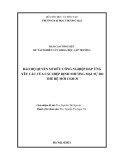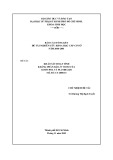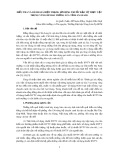
BioMed Central
Page 1 of 15
(page number not for citation purposes)
Implementation Science
Open Access
Research article
An exploration of how clinician attitudes and beliefs influence the
implementation of lifestyle risk factor management in primary
healthcare: a grounded theory study
Rachel A Laws*, Lynn A Kemp, Mark F Harris, Gawaine Powell Davies,
Anna M Williams and Rosslyn Eames-Brown
Address: Centre for Primary Health Care and Equity, School of Public Health and Community Medicine, University of New South Wales, Sydney
NSW 2052, Australia
Email: Rachel A Laws* - r.laws@unsw.edu.au; Lynn A Kemp - l.kemp@unsw.edu.au; Mark F Harris - m.f.harris@unsw.edu.au;
Gawaine Powell Davies - g.powell-davies@unsw.edu.au; Anna M Williams - a.williams@unsw.edu.au; Rosslyn Eames-Brown - rossyln.eames-
brown@heartfoundation.org.au
* Corresponding author
Abstract
Background: Despite the effectiveness of brief lifestyle intervention delivered in primary healthcare (PHC),
implementation in routine practice remains suboptimal. Beliefs and attitudes have been shown to be associated with risk
factor management practices, but little is known about the process by which clinicians' perceptions shape
implementation. This study aims to describe a theoretical model to understand how clinicians' perceptions shape the
implementation of lifestyle risk factor management in routine practice. The implications of the model for enhancing
practices will also be discussed.
Methods: The study analysed data collected as part of a larger feasibility project of risk factor management in three
community health teams in New South Wales (NSW), Australia. This included journal notes kept through the
implementation of the project, and interviews with 48 participants comprising 23 clinicians (including community nurses,
allied health practitioners and an Aboriginal health worker), five managers, and two project officers. Data were analysed
using grounded theory principles of open, focused, and theoretical coding and constant comparative techniques to
construct a model grounded in the data.
Results: The model suggests that implementation reflects both clinician beliefs about whether they should
(commitment) and can (capacity) address lifestyle issues. Commitment represents the priority placed on risk factor
management and reflects beliefs about role responsibility congruence, client receptiveness, and the likely impact of
intervening. Clinician beliefs about their capacity for risk factor management reflect their views about self-efficacy, role
support, and the fit between risk factor management ways of working. The model suggests that clinicians formulate
different expectations and intentions about how they will intervene based on these beliefs about commitment and
capacity and their philosophical views about appropriate ways to intervene. These expectations then provide a cognitive
framework guiding their risk factor management practices. Finally, clinicians' appraisal of the overall benefits versus costs
of addressing lifestyle issues acts to positively or negatively reinforce their commitment to implementing these practices.
Conclusion: The model extends previous research by outlining a process by which clinicians' perceptions shape
implementation of lifestyle risk factor management in routine practice. This provides new insights to inform the
development of effective strategies to improve such practices.
Published: 13 October 2009
Implementation Science 2009, 4:66 doi:10.1186/1748-5908-4-66
Received: 16 June 2009
Accepted: 13 October 2009
This article is available from: http://www.implementationscience.com/content/4/1/66
© 2009 Laws et al; licensee BioMed Central Ltd.
This is an Open Access article distributed under the terms of the Creative Commons Attribution License (http://creativecommons.org/licenses/by/2.0),
which permits unrestricted use, distribution, and reproduction in any medium, provided the original work is properly cited.

Implementation Science 2009, 4:66 http://www.implementationscience.com/content/4/1/66
Page 2 of 15
(page number not for citation purposes)
Background
Lifestyle risk factors such as smoking, poor nutrition,
excessive alcohol consumption, and physical inactivity
are a major cause of preventable mortality, morbidity, and
impaired functioning [1,2]. The World Health Organisa-
tion estimates that 80% of cardiovascular disease, 90% of
type 2 diabetes, and 30% of all cancers could be prevented
if lifestyle risk factors were eliminated [1]. Primary health-
care (PHC) has been recognised as an appropriate setting
for individual intervention to reduce behavioural risk fac-
tors because of the accessibility, continuity, and compre-
hensiveness of the care provided [3]. A growing body of
evidence suggests that brief lifestyle interventions deliv-
ered in PHC are effective [4-8], and the 5A's principle of
brief intervention (ask, assess, advise, assist, and arrange)
has been widely endorsed in preventive care guidelines [9-
12].
Despite this, implementation of risk factor management
in routine practice remains low. Screening for lifestyle risk
factors does not occur routinely, and only a fraction of 'at
risk' patients receive any intervention in PHC [13-16].
Furthermore, studies suggest that when lifestyle interven-
tion is provided it tends to be limited to asking and giving
advice on the health risks of the behaviour rather than
providing assistance, referral, or follow up needed to sup-
port behaviour change [17,18]. The findings of interven-
tion studies aimed at enhancing risk factor management
practices have been mixed and often disappointing [19-
22]. These studies have used a range of intervention strat-
egies; however, they provide little information about the
theoretical or conceptual basis for their choice of interven-
tion and limited contextual data. This suggests that to
improve practices a better conceptual understanding of
the factors impacting on the implementation of lifestyle
risk factor management in routine PHC is required.
Research examining lifestyle risk factor management prac-
tices has consisted predominantly of descriptive studies of
barriers or enablers, or cross sectional studies of self-
reported practices conducted in general practice. These
studies have consistently identified the importance of cli-
nician beliefs, including perceptions about role congru-
ence [23-26], self-efficacy [18,27-29], beliefs about
effectiveness of interventions [24,25,30-33] and patient
motivation [23,34], concern regarding client acceptance
[23-25], as well as personal lifestyle behaviours
[24,35,36]. Few studies have been conducted beyond gen-
eral practitioner (GP) PHC providers. Studies among PHC
nurses, including community nurses, and registered and
licensed practical nurses in USA and Finland, have also
reported the importance of clinician beliefs and attitudes,
mirroring the findings in general practice [36-39].
Our previous research suggests that those who frequently
address risk factors with their patients have different
beliefs and attitudes from those who do so less frequently
[40]. However, as cross-sectional studies these can provide
only limited insight into the way clinician perceptions
shape risk factor management practices, and the impact of
structural or contextual factors on this. A better concep-
tual understanding of how clinician beliefs and attitudes
influence the implementation of risk factor management
in PHC is required to guide the development of effective
strategies to improve practice.
This study builds on our previous cross-sectional study
[40] and aims to: describe a theoretical model for under-
standing how clinician perceptions shape their imple-
mentation of lifestyle risk factor management in routine
practice; and discuss the implications of the model for
developing interventions to improve these practices.
Methods
This study used grounded theory principles, a research
method designed to generate a theoretical explanation of
a social phenomenon that is derived from (grounded in)
empirical data rather than from a preconceived concep-
tual framework [41], and therefore well suited to under-
standing process from the perspective of participants [42].
The approach to grounded theory adopted in this study
was informed by a constructionist perspective [43] which
assumes that neither data nor theories are discovered but
constructed based on shared experiences between
researchers and participants [43]. Hence, the model pro-
duced is a construction of reality offering plausible
accounts and explanations rather than verifiable knowl-
edge.
Study setting and context
This research was part of a larger feasibility project, the
details of which have been reported elsewhere [44,45]. In
brief, the project aimed to develop and test approaches to
integrating the management of lifestyle risk factors into
routine care among PHC providers outside of the general
practice setting. It involved three community health teams
from two Area Health Services (AHS) in the state of New
South Wales (NSW), Australia. In NSW, AHS are responsi-
ble for providing all hospital- and community-based
healthcare apart from general practice and PHC services
for specific population groups such as Aboriginal and
Torres Strait Islanders. Community health services are the
second largest provider of publicly funded PHC services to
the general population after GPs [46].
All eight AHS in NSW were invited to express interest in
participating in the study and to nominate suitable teams.
A total of three community health teams were selected
from two of three AHS who expressed interest. Selection
was based on the capacity of the team to be involved and
the relevance of risk factor management to the type of
service provided and healthcare context. Teams were also

Implementation Science 2009, 4:66 http://www.implementationscience.com/content/4/1/66
Page 3 of 15
(page number not for citation purposes)
selected to maximise the variability in team characteristics
including provider type, team location (co-located or
not), geographical locality, management structures, and
health system context.
Team one (n = 35) was a generalist community nursing
team with both enrolled and registered generalist commu-
nity nurses, located in a metropolitan area. Team two (n =
16) was a co-located multi-disciplinary community health
team from a rural area, while team three (n = 10) con-
sisted of PHC nurses, Aboriginal health workers, and
allied health practitioners providing PHC services to rural
and remote communities that generally did not have
access to other health services such as a GP (see Additional
file 1 for a description of the role of the various commu-
nity health providers involved in the project). In each of
the teams, a baseline needs assessment was conducted to
determine current lifestyle risk factor management prac-
tices, factors shaping practices, and supports required to
improve practices. This needs assessment then informed
the development and implementation of a capacity build-
ing intervention to enhance practices which was tailored
to the needs of each team. Following a six-month imple-
mentation period further data was collected to determine
changes in practices and factors influencing uptake of
practices.
Data sources and collection procedures
This study utilised two sources of data collected as part of
the larger feasibility project: semi-structured interviews
with participants prior to and six months following the
capacity building intervention undertaken with each
team; and project manager journal of reflections and
observations recorded throughout the feasibility project.
As part of the feasibility project, semi-structured inter-
views were conducted with a purposeful sample of partic-
ipants across the three teams at baseline (n = 29) and six
months following the team capacity building intervention
(n = 30). At baseline, the aim was to interview a sample of
clinicians from across the three teams who varied in pro-
fession and role (enrolled and registered nurses, allied
health staff, Aboriginal health workers and managers),
experience, and geographical location. The same partici-
pants were invited to take part in an interview post-inter-
vention (where possible) to provide comparative data on
the same individuals over time. A concerted effort was
also made to identify and approach to take part in an
interview those who felt less positive about the project
and risk factor management in general. These clinicians
were identified through response on a post-intervention
survey and through discussions with managers and
project officers responsible for local implementation.
Full details of the data collection procedures for the qual-
itative interviews have been reported elsewhere [40,45].
In brief, the baseline interviews were conducted by the
project manager (lead author RL) and covered issues
related to barriers, enablers, and capacity to undertake risk
factor management from the perspective of both clini-
cians and managers (Table 1). Following the project, an
evaluation officer (REB) not involved in implementing
the team intervention conducted interviews to explore
participants' experience of attempting to integrate risk fac-
tor management into routine work (Table 1). Interviews
at baseline and post-intervention lasted between 20 and
75 minutes, and were tape recorded with participants' per-
mission and transcribed verbatim. The project manager
(lead author RL) also kept a journal throughout the two-
year project to record reflections and observations follow-
ing interaction with clinicians and managers during field
visits and following participant interviews. All journal
notes were typed and included in the analysis for this
study.
Data analysis and model development
Developing the model involved two main stages of analy-
sis. First, a preliminary model was developed by analysing
a purposeful selection of baseline interviews (n = 18) of
participants who also participated in an interview follow-
ing the project, allowing for comparison over time. Anal-
ysis at this stage involved open and focused coding to
identify key theoretical categories and ideas about how
these were related [47]. From this process, a preliminary
model was constructed and compared to relevant theories
in the literature in order to identify 'conceptual gaps',
heightening the researcher's theoretical sensitivity
[48,49].
The second stage of analysis involved refining the prelim-
inary model through analysis of additional interviews (n
= 30) and the project managers' journal notes. In line with
grounded theory principles [41,50], 10 interviews were
theoretically sampled from the existing interview dataset.
A sampling frame was devised (Table 2) in order to iden-
tify those with a diverse range of attitudes and practices
relevant to the evolving model. Clinician response on a
risk factor management survey undertaken at baseline and
post-intervention was used to identify clinicians meeting
the sampling criteria (details of the survey reported else-
where [40]). A further 20 interviews were purposefully
selected including post-intervention interviews for those
who had participated in an interview at baseline (n = 18)
and interviews with project officers (n = 2) involved in
implementing the project locally. Analysis at this stage
involved assessing how well the focused codes developed
in the preliminary model fitted the new data. This process
resulted in the revision of some categories (for example, to
include additional properties and dimensions) and the
development of additional categories to reflect the data.
Baseline data was then recoded using the new and revised
categories to ensure the conceptual fit with the data. The-

Implementation Science 2009, 4:66 http://www.implementationscience.com/content/4/1/66
Page 4 of 15
(page number not for citation purposes)
Table 1: Topic guide for baseline and post-intervention interviews conducted as part of the feasibility project
Baseline interviews Post-intervention Interviews
• Overview of job role • General impressions of the project
• How addressing SNAP risk factors fits with the job role1/core business
of team or service2
• Case example--last client with a risk factor1
• Approach to addressing SNAP risk factors (client case example)1• Feasibility of risk factor screening/intervention
• Work priority to address SNAP risk factors1• Barriers/enablers risk factor screening/intervention
• Confidence to address SNAP risk factors1• Case example--comfortable to address1
• Barriers and enablers to addressing SNAP risk factors in routine work • Case example--not comfortable to address1
• Support and resources required to address SNAP risk factors in
routine work1/strengthen team capacity to address risk factors 2
• Perceived effectiveness of intervening1
• Opinion on strength of local referral networks and programs to
support risk factor management2
• Congruence with core business of the team and organisation3
• Opinion on team climate and any competing priorities in implementing
the project2
• Process of project implementation (degree of consultation and model
adaptation to suit team)3
• Change in approach to addressing SNAP risk factors
• Views about continuation of risk factor management as part of
professional role1/team or service3
• Support required for continuation of risk factor management practices
in professional role1/team or service3
• Project benefits (personal and professional1/team or service3)
SNAP: Smoking, nutrition, alcohol and physical activity
1Team and service managers only
2Team/service managers and project officers only
Table 2: Criteria used to theoretically sample interviews to include in the analysis
Factors related to key categories in the baseline model
Clinicians who scored low1 or high2 on the following attitude items completed as part of a survey at baseline and/or post-intervention:
• The acceptability of raising risk factor issues with clients
• Perceived work priority
• Perceived effectiveness of addressing lifestyle issues
• Confidence in assessing and managing lifestyle risk factors
• Confidence in applying behaviour change
• Perceived accessibility of support services
Other criteria included
• Clinician types not included in the baseline analysis
• Clinicians reporting change3 in confidence and/or attitudes from baseline to post-intervention:
• Clinicians and managers who have recently joined the team (last six months)
Clinician screening and intervention practices
• Clinicians who had low or high levels of self reported screening for lifestyle risk factors at baseline and/or post-intervention4
• Clinicians who had low or high levels of self reported intervention for lifestyle risk factors at baseline and/or post-intervention5
• Clinicians reporting a change3 in screening and or intervention practices from baseline to post-intervention
1Low defined as scores in the clinician risk factor survey in the lowest quartile for those participating in an interview
2High defined as scores in the clinician risk factor survey in the highest quartile for those participating in an interview
3Change defined as scores increasing from lowest to highest quartile or highest to lowest quartile (baseline to post-intervention)
4High screening practices = mean screening score (across risk factors) in the highest quartile for those participating in an interview, low screening
practices = mean screening score in the lowest quartile for those participating in an interview
5 High intervener = high frequency of intervention for three or more risk factors and/or high intensity intervention (across risk factors), low
intensity intervener = low frequency of intervention for three or more risk factors and/or low intensity intervention (across risk factors).

Implementation Science 2009, 4:66 http://www.implementationscience.com/content/4/1/66
Page 5 of 15
(page number not for citation purposes)
oretical coding was then used to specify the possible rela-
tionships between the categories developed during
focused coding to construct a coherent analytical story
[41,42,47]. Preliminary ideas about relationships were
tested by going back to the data in accordance with
grounded theory principles of moving between induction
and deduction in the development of theory [42].
Throughout the analysis process, constant comparative
techniques were used to assist in uncovering the proper-
ties and dimensions of each category. This involved com-
paring data within the same coding group, making
comparisons between different clinicians and between the
same clinician over time. In line with Strauss and Corbin's
[42] notion of axial coding, attention was paid to identi-
fying and comparing the conditions giving rise to an issue,
the context in which it was embedded, the strategies used
by clinicians to manage this, and the consequences for cli-
nicians beliefs and practices. Insights gained were
recorded in the form of memos throughout the analysis
process. NVivo 7.0 software [51] was used to attach codes
to text, record memos, and diagrams, as well as facilitate
the retrieval of data.
One member of the research team (RL) undertook the
analysis. To avoid the researchers' views being 'imposed'
on the data, RL documented assumptions prior to analysis
and kept an audit trail to document coding decisions,
which included extensive use of participant quotes to jus-
tify the approach taken [52]. A conscious decision was
made not to use member checking, a process of cross-
checking findings and conclusions with participants. As
the purpose of the analysis was to code all responses and
organise into a new higher order theoretical model, it was
not expected that participants would be able to recognise
their individual contributions or concerns. It was there-
fore not appropriate to seek 'validation' from individual
participants. Instead, a number of other techniques were
used to ensure interpretations were grounded in the data.
These included the use of constant comparisons, memo
writing, extensive use of participant quotes, and discuss-
ing coding frameworks and preliminary theoretical ideas
with two other members of the research team (MH and
LK) for the purpose of gaining other perspectives and
challenging assumptions rather than to reach agreement.
Ethics
The project was approved by the UNSW Human Research
Ethics Committee (HREC) and the HREC in each AHS.
Results
The final sample in this study included 48 interviews with
23 clinicians, three team managers, two senior commu-
nity health managers, and two project officers. Fourteen
clinicians and four managers were interviewed twice, at
the beginning and end of the project. The sample included
generalist community nurses, child and family nurses, a
range of allied health providers, and one Aboriginal
health worker. All were female, with a wide range of pro-
fessional experience. The interview sample included in
this study was broadly representative of clinicians from
the three teams (Table 3). However, allied health practi-
tioners and child and family nurses from team two were
over-represented and males under-represented in the
interview sample. This reflected the purposeful and theo-
retical sample techniques that aimed to include a diverse
range of clinician types and those with varying levels of
attitudes and practices related to the management of life-
style risk factors.
Model Overview
The theoretical model is shown in Figure 1. It suggests that
clinician perceptions shape their risk factor management
practices through the process of 'practice justification'.
This involves justifying risk factor management practices
as a legitimate, 'doable,' and worthwhile component of
the role. This process consists of five main interrelated fac-
tors:
1. Developing commitment (Should I address lifestyle
issues?)
2. Assessing capacity (How can I address lifestyle issues?)
3. Formulating intervention role expectations/intentions
(How will I intervene?)
4. Implementing risk factor management practices
5. Weighing up benefits and costs of practice (Is it worth
it?)
Each of these steps in the model is described below.
Developing commitment--Should I address lifestyle issues?
First, 'commitment' represents the priority or importance
placed on risk factor management in the role, influencing
'if and when' clinicians address lifestyle issues, the
amount of time they are willing to invest, and the scope of
their practice (type of risk factors addressed and frequency
in which this occurred). Commitment in turn appeared to
be shaped by three main factors, as outlined in Figure 1:
role responsibility congruence, perceptions of client
receptiveness, and beliefs about the 'scope to make a dif-
ference'.
Clinicians expressed a diversity of views about how
addressing lifestyle issues fitted with their role responsi-
bilities. For some, it was simply an assessment task to 'tick
off' before getting on with the job of looking after the cli-








![Vaccine và ứng dụng: Bài tiểu luận [chuẩn SEO]](https://cdn.tailieu.vn/images/document/thumbnail/2016/20160519/3008140018/135x160/652005293.jpg)

















